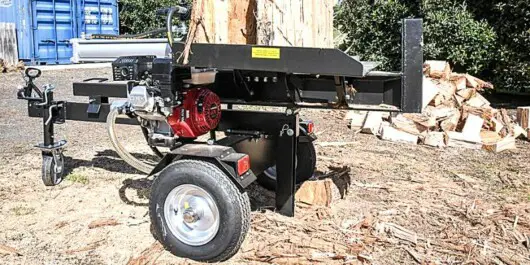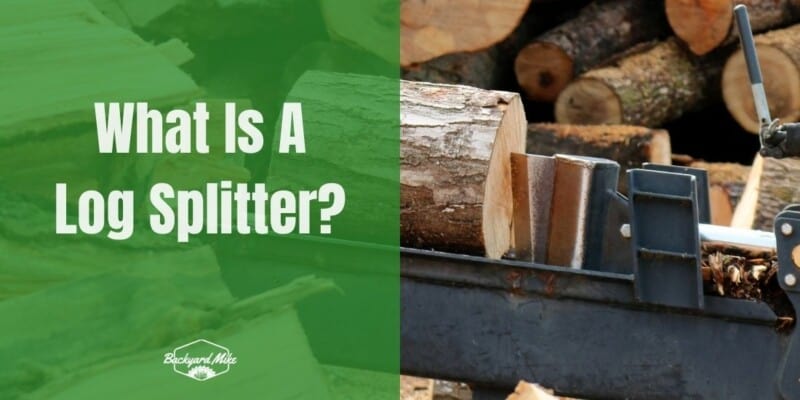Are you a homeowner looking for an effective way of cutting logs but don’t know what is log splitter? If yes, then you are definitely in the right place.
A log splitter is a simple hydraulic device that you’ll find being used for splitting large pieces of wood. A log splitter contains all the basic components of a hydraulic machine and is helpful for a wide variety of reasons. It consists of components like an engine, a hydraulic oil pump, a tank, valves, a hydraulic cylinder, and more.
In this article, you’ll get to know all about log splitters, what is a log splitter, factors to consider before selecting a log splitter, what to look for in a log splitter, and more. Stick around to get all the answers that you’re looking for.
What is a log splitter?
A log splitter is essentially a piece of machinery that is used for splitting large pieces of wood into smaller pieces of firewood. Log splitters can be used by homeowners and in commercial settings. The simplest hydraulic device that you’ll be able to find in common usage these days is the log splitter. It contains all the basic components of a hydraulic machine.
- An engine, generally a small four-stroke gasoline engine, will deliver the power to the system
- The engine is attached to the hydraulic oil pump, which creates a stream of high-pressure oil that runs to a valve
- The valve will allow the operator to actuate the hydraulic cylinder for splitting the log
- There is also a tank for holding the hydraulic oil that feeds the pump and a filter to keep the oil clean
Valves are capable of applying both backward and forward pressure to the piston. One type of valve is the spool valve due to its resemblance to a spool from a spool of threads. Taking a trip down to your local tool supplier will allow you to look at backyard log splitters. A typical backyard log splitter usually has –
- A 5HP gasoline engine
- A 3.5-gallon hydraulic oil tank
- A 4-inch diameter, 24-inch hydraulic cylinder
- A two-stage hydraulic oil pump rated at a maximum of 11 gallons per minute (3gpm at 2,500 psi)
The two-stage pump is an ingenious time-saver for your log splitter needs. The pump essentially contains two pumping sections as well as an internal pressure-sensing valve that can cut over between the two. A section of the pump is capable of generating the maximum gpm flow rate at a lower pressure. It’s used for drawing the piston back out of a log once the log has been split. Drawing the piston back into the cylinder will take little force, and you’ll want this to happen quickly. You should look for the highest possible flow rate at low pressure. When you’re pushing the piston into a log, you’ll want the highest possible pressure to generate the maximum splitting force. The flow rate isn’t really a big concern, so the pump will switch to its high-pressure, low-value stage for splitting the logs.
Which splitter option is the right tool for the job?
Log splitters are generally available in electric, hydraulic (3-point linkage), and hydraulic (petrol) models. Electric log splitters are comparatively cheaper than hydraulic log splitters. However, they usually come with half the power of a hydraulic log splitter. Electric log splitters are limited in power, and they aren’t suitable for green or hard timbers. If you’re after the ability to split hard timbers, a hydraulic splitter will be the best option.
When looking for petrol or gas-powered look splitters, look at the horse-power rating and the tonnage. They’ll determine the exact power of the machine. In contrast, a 3-pt linkage splitter’s capacity will be determined not just by the HP rating and tonnage, but by the hydraulics as well. If your budget can afford a hydraulic splitter, it should be preferred over an electric splitter.
What to look for in a log splitter?
Before finalizing the log splitter option, there are certain things that you must consider before you spend your hard-earned money. You wouldn’t want to go in blind on your purchase and make an expensive mistake that you would later regret. Electric log splitters can be pretty difficult to work with if they aren’t that good. You must read reviews on them before you take the plunge and see what other users’ experiences have been with them.
Make sure that you’ve got a log splitter that has ample force to split the logs you’ll want is at the top of the list of things to check. You’ll need to have enough splitting force if you’re planning to split larger logs. You can save money if you decide to go with a smaller splitter if you’re going to cut small logs.
If you’re planning to split away from your backyard and use a generator, it would be a smart idea to check and see if your log splitter can be towed, as it’ll be important. If it cannot be towed, some people might look to put it in the back of their truck. This is a great alternative as long as you’re able to.

Does the log splitter have multiple positions in which you can split logs? Most high-quality log splitters will allow you to split larger logs. It’ll also stop you from needing to lift logs, which could hurt your back. If it has a vertical position, it’ll instantly put it back at the top of the list.
Does your log splitter come with extra features, and does the manufacturer offer 4-way splitting wedges? A 4-way splitting wedge will make a huge difference in how long it’ll take to split logs. As you won’t need to do multiple splits of a log, it’ll make things much quicker.
The price you’re willing to pay, and your overall budget, will be up to you. If it costs a lot, and it doesn’t offer everything you want, it won’t be worth purchasing. It’s subjective, but the price is something to consider if you’re coming up with a budget.
Should you get an electric log splitter or a gas log splitter?
This is a highly subjective question, as the situation of the first individual will be very different from other individuals. If you ask someone who needs to split 5-inch logs with a 5-ton electric splitter, they’ll say yes, they’re good. You ask someone who has to split 30-inch hardwood logs, and they’ll likely say no.
This is why it is always suggested that you should consider your situation before you decide which log splitter to go for. By doing this, you wouldn’t just save yourself money, but you’ll also save on headaches. Getting the right tool for the job will be more important than having the most powerful option.
If you’re going to split close to home, then an electric log splitter will be a smart choice. However, make sure that you’re choosing the right ton model. It can save you headaches in the winter months when it’s cold outdoors, and you’ll have to emergency split logs. Although, it would be better to have your logs split before the winter start.
If you need to split the largest and hardest logs, then you should go for a gas log splitter. A large gas log splitter would suit you much better. This is why you’ll need to be thorough in your research so that you aren’t caught out.
Conclusion
Thank you for reading. Hopefully, now you know a lot more about log splitters, what is a log splitter, factors to consider before selecting a log splitter, what to look for in a log splitter, and more. A log splitter is a simple hydraulic device that you’ll find being used for splitting large pieces of wood. A log splitter contains all the basic components of a hydraulic machine and is helpful for a wide variety of reasons. It consists of components like an engine, a hydraulic oil pump, a tank, valves, a hydraulic cylinder, and more.


